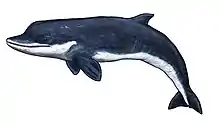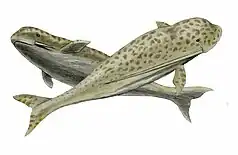| Awadelphis Temporal range: Late Miocene 6.3–5.7 Ma | |
|---|---|
| Scientific classification | |
| Domain: | Eukaryota |
| Kingdom: | Animalia |
| Phylum: | Chordata |
| Class: | Mammalia |
| Order: | Artiodactyla |
| Infraorder: | Cetacea |
| Superfamily: | Inioidea |
| Family: | incertae sedis |
| Genus: | †Awadelphis Murakami, 2016 |
| Species: | †A. hirayamai |
| Binomial name | |
| †Awadelphis hirayamai Murakami, 2016 | |
Awadelphis hirayamai is a species of extinct oceanic river dolphin discovered in the Senhata Formation of Japan dating around 6 million years ago (mya). The genus name derives from Awa, an ancient name for the Chiba Prefecture where the holotype specimen was collected, and Ancient Greek delphis meaning "dolphin"; the species name honors the discoverer of the holotype, Ren Hirayama. It may have inhabited a subpolar environment. Awadelphis and other river dolphins of the Late Miocene may have been in abundance due to the decline of competing ancient dolphins and porpoises.[1]
References
- ↑ Murakami, M. (2016). "A New Extinct Inioid (Cetacea, Odontoceti) from the Upper Miocene Senhata Formation, Chiba, Central Japan: The First Record of Inioidea from the North Pacific Ocean". Paleontological Research. 20 (3): 207–225. doi:10.2517/2015PR031. S2CID 132209924.
This article is issued from Wikipedia. The text is licensed under Creative Commons - Attribution - Sharealike. Additional terms may apply for the media files.

